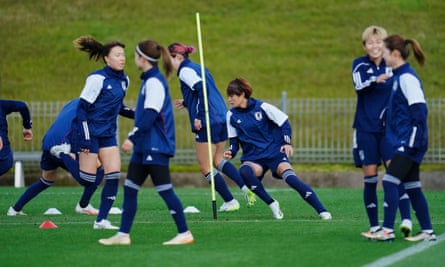Hinata Miyazawa: how Japan’s unlikely star took World Cup by storm
If this World Cup has taught us anything, it is to expect the unexpected. No player exemplifies this better than Japan’s Hinata Miyazawa. The 23-year-old has been the star of the team that has taken the tournament by storm, raising the question of how she arrived in Australia and New Zealand so unnoticed.
Her story began in a small coastal town, an hour’s drive south of the Japanese capital. For Miyazawa football started at home with her older brother Keita, an amateur player, introducing her to the game at the age of three.
“I sometimes feel disappointed that I was never selected for the national team” he says, before adding: “So I’m happy she’s doing what she does best: scoring goals.” Her elder sibling’s influence remains intact to this day. Miyazawa consults with Keita after matches in search of a reliable evaluation of her performance. “I always appreciate an objective opinion,” she says.
Since stepping into the limelight Miyazawa, whose Japan face Sweden in the quarter-finals on Friday, has displayed nothing but modesty when quizzed on her recent run of form. “I was happy to score two goals but this was a team effort” she said following Japan’s remarkable 4-0 win over Spain. “The defence did its job and I was given with the right pass at just the right time. This is what enabled me to put the ball in the net.”
True to her humble beginnings, Miyazawa avoided the elite academy route as a pathway into football. She is one of just six members of the Nadeshiko 23-member squad to have committed to her junior high and high school throughout the crucial, early-teenage development years.
A standout performer at school, her first call up to the Japan national side came at 15. The Japan Under-16s, affectionately dubbed Little Nadeshiko, did well to reach the final of the 2015 edition of the AFC U-16 Women’s Championship with Miyazawa scoring five goals. She moved up through the age groups before playing a crucial role in Japan’s triumph at the 2018 Under-20 World Cup in France, a campaign overseen by the current Nadeshiko coach, Futoshi Ikeda.
By this point Miyazawa had found her preferred position as an attacking midfielder and a predictable offer came upon high school graduation in 2018. She signed with then reigning Nadeshiko League champions, Tokyo Verdy Beleza, but not without an important condition.
This was still the amateur age of women’s football in Japan and career prospects were at the forefront of her thinking. Aged 18, she decided to pursue an academic career alongside football. The prestigious faculty of sports and health science at the renowned Hosei University in Tokyo became her base, outside of football, from then on.
“At university everyone does their own thing but we all study together in the same faculty. It’s interesting to hear stories from people of various backgrounds. I made a lot of friends and I’m glad I decided to enroll,” Miyazawa said.
After two prosperous seasons with Beleza the time had come for a new challenge. Once again Hinata would take a separate path to other teammates, many of whom secured illustrious moves to the global elite. The inception of Japan’s first professional women’s league was at hand.
Enticed by an intriguing new project, and an exciting new style of play under then manager Takeo Matsuda, Hinata accepted an offer from little-known Mynavi Sendai in the north of Japan. Online classes were the norm after the pandemic and the student-cum-professional footballer completed her studies 360km from the classroom. “I still don’t see myself as a ‘pro’,” Miyazawa said at the time. “I’m also a student but I realise the responsibilities I now carry are different than before [turning professional].”
after newsletter promotion

Ikeda’s faith in Hinata has been unwavering and he has involved the dynamic playmaker in most iterations of his Japan side. Possession-based football is the first order of business for the coach and he has found an optimal role for this technically gifted player.
At this World Cup Japan have opted to drop the central striker into a deeper, chance-creating role with the left and right forwards playing a little higher than before. Occupying the left side of attack, Miyazawa has flourished as a result. She now finds herself with ample space and time to showcase her talents with devastating results.
Japan have also added a counterattacking element to their game plan Miyazawa the focal point. This has uncovered previously unseen attributes of pace and composure in one-on-ones.
Her remarkable run of form at this tournament will no doubt draw interest from the world’s elite sides. With a tendency to shy away from stardom and prestige, it is difficult to predict the path she will take when the dust settles. Perhaps the one thing we can bank on, however, is that her motivations will ring true to her love of the game and, indeed, herself.